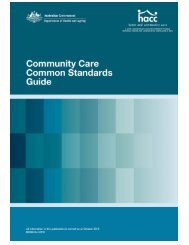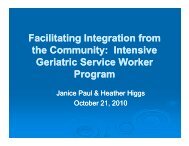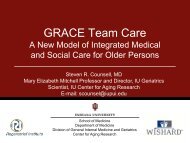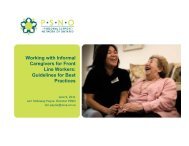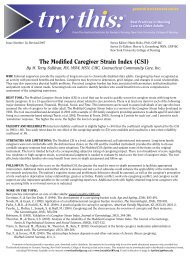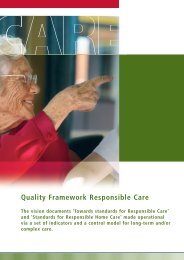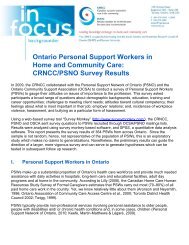Seniors in need, caregivers in distress:
Seniors in need, caregivers in distress:
Seniors in need, caregivers in distress:
You also want an ePaper? Increase the reach of your titles
YUMPU automatically turns print PDFs into web optimized ePapers that Google loves.
14 Health Council of Canada<br />
such as challeng<strong>in</strong>g behaviour or physical disability<br />
comb<strong>in</strong>ed with cognitive impairment. Their family <strong>caregivers</strong><br />
have the highest risk of burnout, and the seniors have a<br />
high risk of placement <strong>in</strong> long-term care facilities if they and<br />
their families do not receive the support services they <strong>need</strong>.<br />
Our analyses show that <strong>in</strong>creas<strong>in</strong>g levels of <strong>need</strong> are not<br />
necessarily matched by <strong>in</strong>creas<strong>in</strong>g levels of home care<br />
services. High-<strong>need</strong>s seniors receive, at most, a few more<br />
hours of care per week than those with moderate <strong>need</strong>s.<br />
In some regions, the hours of care do not <strong>in</strong>crease at all.<br />
Due to limited fund<strong>in</strong>g, some prov<strong>in</strong>ces and territories<br />
cap the number of hours or spend<strong>in</strong>g on home care clients<br />
to the equivalent cost of a bed <strong>in</strong> a long-term care facility. 5<br />
As we will discuss <strong>in</strong> the next section of the report, this<br />
is caus<strong>in</strong>g significant stress for many of their <strong>caregivers</strong>.<br />
Pa<strong>in</strong>, depression, and falls are common problems<br />
The RAI-HC analyses also showed that:<br />
• More than half of all clients <strong>in</strong> each region experience pa<strong>in</strong>,<br />
with about 15% suffer<strong>in</strong>g from severe pa<strong>in</strong>.<br />
• At least 30% of clients <strong>in</strong> each region require a care plan<br />
for depression. Many seniors are tak<strong>in</strong>g antidepressants<br />
(17 – 30%) and 8 – 19% are tak<strong>in</strong>g sleep<strong>in</strong>g pills (hypnotics),<br />
which can <strong>in</strong>crease the risk of falls.<br />
• Approximately 16 – 19% of clients had experienced one fall<br />
<strong>in</strong> the 90 days prior to their assessment, and 9 – 24% had<br />
suffered two or more falls.<br />
• In the 90 days prior to their assessment, 10 – 20% of home<br />
care clients had visited a hospital emergency department,<br />
and at least one-quarter or more of clients <strong>in</strong> all five regions<br />
had been hospitalized.<br />
Challenges with daily liv<strong>in</strong>g<br />
Analyses of RAI-HC assessments show that 95– 98% of<br />
home care clients have some level of difficulty with<br />
activities such as clean<strong>in</strong>g, cook<strong>in</strong>g, grocery shopp<strong>in</strong>g, and<br />
home ma<strong>in</strong>tenance (called <strong>in</strong>strumental activities of daily<br />
liv<strong>in</strong>g, or IADLs). A considerable number (23 – 41%) <strong>need</strong><br />
help with fundamental activities such as bath<strong>in</strong>g, eat<strong>in</strong>g,<br />
and toilet<strong>in</strong>g (called activities of daily liv<strong>in</strong>g, or ADLs).<br />
What home care provides—and doesn’t<br />
When someone is referred to home care, a case manager<br />
typically meets with the client and often the family caregiver<br />
to conduct an assessment. Once someone is assessed<br />
as <strong>need</strong><strong>in</strong>g home care, the case manager coord<strong>in</strong>ates care<br />
and authorizes all other home care services a client may<br />
<strong>need</strong>. The case manager cont<strong>in</strong>ues to monitor levels of<br />
<strong>need</strong> and may make changes <strong>in</strong> the care plan as required.<br />
All prov<strong>in</strong>ces and territories can provide a personal support<br />
worker and /or nurse, depend<strong>in</strong>g upon <strong>need</strong>. A personal<br />
support worker helps with basic daily liv<strong>in</strong>g <strong>need</strong>s (such as<br />
bath<strong>in</strong>g and toilet<strong>in</strong>g), and may help with a limited number<br />
of broader activities (such as the client’s laundry). A nurse<br />
may provide cl<strong>in</strong>ical care such as chang<strong>in</strong>g the dress<strong>in</strong>g<br />
on a wound or monitor<strong>in</strong>g the client’s condition. Depend<strong>in</strong>g<br />
on the jurisdiction and client <strong>need</strong>s, home care teams<br />
can also <strong>in</strong>clude occupational therapists, physiotherapists,<br />
pharmacists, nurse practitioners, social workers, dietitians<br />
and physicians. 5<br />
A considerable number<br />
(23-41%) of home care clients <strong>need</strong> help with<br />
activities such as bath<strong>in</strong>g, eat<strong>in</strong>g, and toilet<strong>in</strong>g



